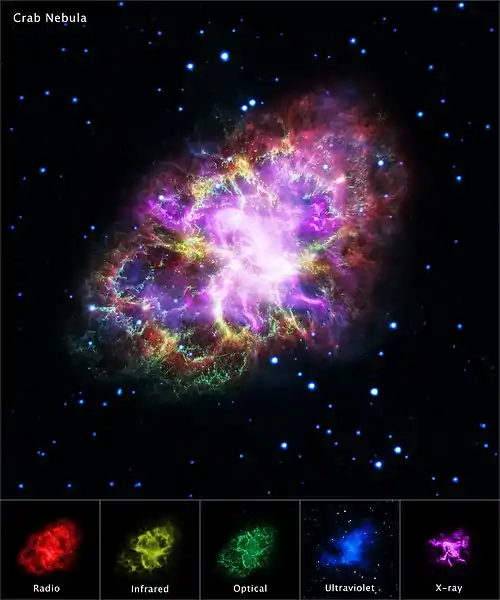Gloria Mabel Dubner | |
|---|---|
.jpg.webp) | |
| Born | May 5, 1950 |
| Nationality | Argentinian |
| Alma mater | University of Buenos Aires, Licensure degree, 1974 National University of La Plata, PhD, 1982 |
| Known for | Leading the team that produced the highest quality image of the Crab Nebula |
| Scientific career | |
| Fields | Astrophysics |
| Institutions | Instituto de Astronomía y Física del Espacio National Scientific and Technical Research Council Argentine Institute of Radio Astronomy |
| Doctoral advisor | Fernando Raúl Colomb |
Gloria Dubner (born May 5, 1950) is an Argentinian astrophysicist and Director of the Instituto de Astronomía y Física del Espacio in Buenos Aires and a Senior Researcher at the National Scientific and Technical Research Council. She is known for her research on supernovas.
Education
Dubner was born on May 5, 1950, in the city of Chajarí, located in the Entre Ríos Province in Argentina. She received her Licentiate degree in physics in 1974 from the University of Buenos Aires at the age of 23. She then attended National University of La Plata, where she received her PhD in physics in 1982 under the mentorship of astronomer and Guggenheim Fellow Fernando Raúl Colomb.[1]
Research and career
Career trajectory
Between 1975 and 1987, Dubner worked at the Argentine Institute of Radio Astronomy. In 1988, she began working at the Instituto de Astronomía y Física del Espacio (IAFE).[2] In 1997, she also was appointed as a researcher at the National Scientific and Technical Research Council, continuing her study of supernovas.[3] In 2009, she became the Director of IAFE and also serves as the Director of the Supernovas and Interstellar Environment group.[4]

Research contributions
Dubner has participated in a number of international collaborations to study galactic supernova remnants. For instance, in 1994, she and her American collaborators Frank Winkler and W. Miller Gross were awarded a National Science Foundation grant to image the expanding shell of gas left over after a star explodes using data collected from radio telescopes in the US and Argentina.[5]
Starting in 2015, Dubner also led a collaboration between five observatories that led to the production of the most detailed image produced of the Crab Nebula, a bright supernova explosion first observed by Chinese astronomers in 1054.[6][7][8] The collaboration leveraged data collected at different wavelengths to create a composite image using: infrared data generated by the Spitzer Space Telescope from NASA's Jet Propulsion Laboratory, visible light data from the Hubble Space Telescope, ultraviolet data from the XMM-Newton operated by the European Space Agency, radio image and X-ray data from NASA's Chandra X-ray Observatory, and radio data from the Very Large Array operated by the National Radio Astronomy Observatory.[9]
Leadership and recognition
Dubner is an active member of the International Astronomical Union (IAU), serving on a variety of commissions including the Working Group for Historic Radio Astronomy, the Division for Interstellar Matter and Local Universe, and the Commission for Astrochemistry.[10] In 2006, she served on the Organizing Committee to report advances in the field of radio astronomy between 2002 and 2005.[11] In 2012, she was part of the organizing committee of the IAU's XXVIII General Assembly for Women in Astronomy Meeting.[12] In June 2008, the minor planet 9515 Dubner was named in her honor, recognizing her achievements at the IAU.[13] The planet was first discovered at the observatory in El Leoncito National Park in 1975.[14]In 2023 she won the Platinum Konex Award as the most important physicist in Argentina.[15][16]
References
- ↑ Colomb, F. R.; Dubner, G. (1982-08-01). "Neutral hydrogen associated with southern supernova remnants. II - Lupus Loop". Astronomy and Astrophysics. 112: 141–148. Bibcode:1982A&A...112..141C. ISSN 0004-6361.
- ↑ Dubner, GM; Arnal, EM (1988). "Neutral hydrogen and carbon monoxide observations towards the SNR Puppis A". Astronomy and Astrophysics Supplement Series. 75: 363–369. Bibcode:1988A&AS...75..363D.
- ↑ Giacani, E. B.; Dubner, G. M.; Kassim, N. E.; Frail, D. A.; Goss, W. M.; Winkler, P. F.; Williams, B. F. (1997-04-01). "New Radio and Optical Study of the Supernova Remnant W44". The Astronomical Journal. 113: 1379. Bibcode:1997AJ....113.1379G. doi:10.1086/118352. ISSN 0004-6256.
- ↑ Cesarsky, Catherine; Walker, Helen (2010). "Head count: statistics about women in astronomy". Astronomy & Geophysics. 51 (2): 2.33–2.36. doi:10.1111/j.1468-4004.2010.51233.x. ISSN 1468-4004.
- ↑ "NSF Award Search: Award#9314174 - U.S.-Argentina: Radio Observations of Galactic Supernova Remnants and their Interaction with the Interstellar Medium". www.nsf.gov. Retrieved 2018-12-27.
- ↑ "Incredible New Image Of The Crab Nebula Created By 5 Telescopes Combined". IFLScience. Retrieved 2018-12-27.
- ↑ Dubner, G.; Castelletti, G.; Kargaltsev, O.; Pavlov, G. G.; Bietenholz, M.; Talavera, A. (2017). "Morphological Properties of the Crab Nebula: A Detailed Multiwavelength Study Based on New VLA, HST , Chandra , and XMM-Newton Images". The Astrophysical Journal. 840 (2): 82. arXiv:1704.02968. doi:10.3847/1538-4357/aa6983. ISSN 0004-637X. S2CID 119072136.
- ↑ Siegel, Ethan. "Spectacular New Crab Nebula Images Close In On Its Final Secrets". Forbes. Retrieved 2018-12-27.
- ↑ "Observatories Combine to Crack Open the Crab Nebula". NASA/JPL. Retrieved 2018-12-27.
- ↑ "International Astronomical Union | IAU". www.iau.org. Retrieved 2018-12-27.
- ↑ Engvold, Oddbjorn (2007-05-10). Reports on Astronomy 2003-2005 (IAU XXVIA): IAU Transactions XXVIA. Cambridge University Press. pp. 313–318. ISBN 9780521856041.
- ↑ "International Astronomical Union | IAU". www.iau.org. Retrieved 2018-12-27.
- ↑ "Asteroide Dubner". tux.iar.unlp.edu.ar. Retrieved 2018-12-27.
- ↑ "IAU Minor Planet Center". www.minorplanetcenter.net. Retrieved 2018-12-27.
- ↑ "Gloria Dubner | Fundación Konex". www.fundacionkonex.org (in Spanish). Retrieved 2023-10-04.
- ↑ "El listado completo de los científicos distinguidos con los premios Konex de Brillante y Platino". infobae (in European Spanish). 2023-10-02. Retrieved 2023-10-04.